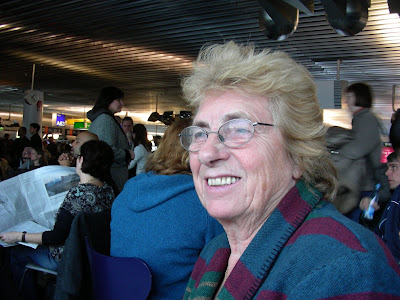 at the moment I am flying in an airplane that is traveling west at something like half the speed of the planet and time makes no sense whatsoever. I just know that it is passing. We are over Greenland, and the sky is dark except for a thin red line on the southern horizon outside my window. According to Mo’s watch, it is 10:00 AM in San Francisco, and we will land there at 5:00PM this afternoon. We left Frankfurt at 4 in the afternoon, same day, and yet time is passing. I am not sure why it is night here, because it isn’t even nighttime here according to the time zone we are supposedly in, but I guess we are so far north that at this time of year it is always night anyway. It’s all crazy.
at the moment I am flying in an airplane that is traveling west at something like half the speed of the planet and time makes no sense whatsoever. I just know that it is passing. We are over Greenland, and the sky is dark except for a thin red line on the southern horizon outside my window. According to Mo’s watch, it is 10:00 AM in San Francisco, and we will land there at 5:00PM this afternoon. We left Frankfurt at 4 in the afternoon, same day, and yet time is passing. I am not sure why it is night here, because it isn’t even nighttime here according to the time zone we are supposedly in, but I guess we are so far north that at this time of year it is always night anyway. It’s all crazy.At 4am this morning, Istanbul was vibrant with street life. We rode the bus through the city to the airport amazed at all the activities going on there. People coming out of bars, standing on corners, buying cigarettes and groceries, doing the Turkish man thing of standing around shooting the breeze. Except it was 4am. Amazing.
I fell in love with Germany today, somewhere between Switzerland and Munich. The Alps were covered with snow and the plains around Munich are like something in a fairy tale. The fields are still green, and a magical patchwork of angles of varying shades of green, with patches of dark forest, dotted with perfect little villages of white with red roofs. The roads looked nearly empty, with traffic moving along the major highways smoothly. The sunlight was coming over the magnificent snow covered mountains to the south and angled across the green fields and forests in a way that made me think of what life must be like in a small German village, and suddenly I wanted very badly to experience Germany.
 The airport at Munich was clean and full of bustling activity, with great shops and clothes and wonderful smelling food. It made me laugh at how I felt about Germany at the beginning of this trip and it made Mo happy that I decided I really liked Germany after all. She has many happy memories of traveling in this country. I hope I get to do that someday. Guess it’s a good thing that I am learning to drink beer.
The airport at Munich was clean and full of bustling activity, with great shops and clothes and wonderful smelling food. It made me laugh at how I felt about Germany at the beginning of this trip and it made Mo happy that I decided I really liked Germany after all. She has many happy memories of traveling in this country. I hope I get to do that someday. Guess it’s a good thing that I am learning to drink beer.Now the red line changed to a deep deep blue, and in a matter of moments back to the faintest hint of orange again. Maybe we are going towards some kind of daylight?
The trip is very nearly over, the final travels are ending, and the integration of all I learned and experienced is waiting in the wings. I am sure that more will come to me, the deeper part of Turkey as a cradle of civilization in the world, and the blessing of traveling to a place never thought of much and learning about it in a way you can never do without being there. This fluorescent thin blue line on the dark horizon is a great symbol of the end of this trip. Too bad I can’t take a picture of it. I guess it’s another one of those experiences that can’t be caught and just has to be felt.
Later at home:
I am discovering some of the things that I appreciate much more after traveling in a foreign country! toilet paper, light bulbs that are actually bright enough to see, electricity that works steadily all the time, lots of clean clothes to choose from, good brewed coffee, not Turkish and not NesCafe! and the ability to buy aspirin or cough drops at the grocery store without having to find a pharmacy!








 The ruins themselves are not especially exciting, a great remnant of a Roman aqueduct, some large baths, and a truly beautiful theater are the standouts, but the setting is probably the most beautiful in all of Turkey. The harbors are especially gorgeous, with crystal water, sandy and rocky beaches surrounded by forests and Mt Olympus, one of 22 such named mountains in Greece and Turkey, rising to more than 7,000 feet above the sea.
The ruins themselves are not especially exciting, a great remnant of a Roman aqueduct, some large baths, and a truly beautiful theater are the standouts, but the setting is probably the most beautiful in all of Turkey. The harbors are especially gorgeous, with crystal water, sandy and rocky beaches surrounded by forests and Mt Olympus, one of 22 such named mountains in Greece and Turkey, rising to more than 7,000 feet above the sea. 
